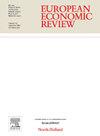走向一个基于相邻可能理论的一般创造力模型
IF 2.4
2区 经济学
Q1 ECONOMICS
引用次数: 0
摘要
本文介绍了一个通用的创造力模型(GMC),作为相邻可能理论(TAP)的延伸,解决了一个长期存在的差距:缺乏一个公式来形式化从创造力理论中获得的广泛见解。GMC借鉴了多种创造力文献,特别是创造力的系统观(SVC)、盲变和选择性保留(BVSR)框架和磨光理论(HT),将认知过程、领域级把关和更广泛的选择压力纳入一个类似于tapa的方程,并形式化了创造力文献中主要叙述的几个过程。除了这个等式,一个基于Csikszentmihalyi的SVC的图形版本描绘了从文化知识,通过个人洞察力和领域评估,到将新奇事物整合回领域的创作周期。为了证明该模型的解释力,GMC被应用于模拟科学中多个独立发现的充分记录现象,从而将TAP的范围扩展到创造力研究中的一个关键经验规律。本文章由计算机程序翻译,如有差异,请以英文原文为准。
Towards a general model of creativity based on the theory of the adjacent possible
This paper introduces a General Model of Creativity (GMC) as an extension of the Theory of the Adjacent Possible (TAP) addressing a longstanding gap: the lack of an equation that formalizes a wide range of insights from creativity theory. The GMC draws on multiple strands of creativity literature, particularly the systems view of creativity (SVC), the blind-variation and selective-retention (BVSR) framework, and honing theory (HT), incorporating cognitive processes, field-level gatekeeping, and broader selective pressures into a TAP-like equation, and formalizing several processes that have remained largely narrative in the creativity literature. Alongside the equation, a graphical version building on Csikszentmihalyi’s SVC maps the creative cycle from cultural knowledge, through individual insight and field evaluation, to the integration of novelties back into the domain. To demonstrate the model’s explanatory power, the GMC is applied to simulate the well-documented phenomenon of multiple independent discoveries in science, thereby extending TAP’s reach to a key empirical regularity in creativity research.
求助全文
通过发布文献求助,成功后即可免费获取论文全文。
去求助
来源期刊

European Economic Review
ECONOMICS-
CiteScore
4.70
自引率
3.60%
发文量
170
期刊介绍:
The European Economic Review (EER) started publishing in 1969 as the first research journal specifically aiming to contribute to the development and application of economics as a science in Europe. As a broad-based professional and international journal, the EER welcomes submissions of applied and theoretical research papers in all fields of economics. The aim of the EER is to contribute to the development of the science of economics and its applications, as well as to improve communication between academic researchers, teachers and policy makers across the European continent and beyond.
 求助内容:
求助内容: 应助结果提醒方式:
应助结果提醒方式:


